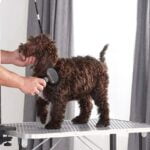Table of Contents
Pet food allergies can cause significant discomfort and health issues for your furry friends. Identifying and managing these allergies is crucial for their well-being. This guide provides essential tips on how to detect pet food allergies, ensuring your pet maintains optimal health and comfort.

1. Recognize the Symptoms
Identifying the symptoms of pet food allergies is the first step:
- Itching and Scratching: Excessive itching, scratching, or licking, especially around the face, paws, and ears.
- Gastrointestinal Issues: Vomiting, diarrhea, or chronic gas can indicate food allergies.
- Skin Problems: Redness, rashes, hives, or hotspots on the skin.
- Ear Infections: Recurrent ear infections can be a sign of food allergies.
- Behavioral Changes: Irritability or lethargy due to discomfort.
2. Keep a Food Diary
Tracking your pet’s diet can help identify potential allergens:
- Daily Log: Record everything your pet eats, including treats and table scraps.
- Monitor Symptoms: Note any symptoms that occur after meals.
- Identify Patterns: Look for patterns or correlations between specific foods and allergic reactions.
3. Conduct an Elimination Diet
An elimination diet can help pinpoint specific allergens:
- Choose Hypoallergenic Foods: Start with a diet of limited ingredients that your pet hasn’t been exposed to before.
- Monitor Reactions: Feed the hypoallergenic diet exclusively for 8-12 weeks, observing any changes in symptoms.
- Reintroduce Foods: Gradually reintroduce old foods one at a time, monitoring for any reactions.
4. Consult Your Veterinarian
Professional guidance is essential for managing food allergies:
- Veterinary Examination: Schedule a thorough exam to rule out other causes of symptoms.
- Allergy Testing: Your vet may recommend blood tests or intradermal skin testing to identify specific allergens.
- Dietary Recommendations: Follow your vet’s advice on suitable diets and feeding practices for your pet.
5. Consider Commercial Hypoallergenic Diets
Specialized diets can help manage food allergies:
- Prescription Diets: Ask your vet about prescription hypoallergenic diets designed for pets with food allergies.
- Limited Ingredient Diets: Choose commercial diets with limited ingredients to reduce the risk of allergic reactions.
- Quality Brands: Select reputable brands known for quality and safety standards.
6. Avoid Common Allergens
Some ingredients are more likely to cause allergies:
- Proteins: Beef, chicken, lamb, and fish are common allergens.
- Grains: Wheat, corn, and soy can trigger allergic reactions in some pets.
- Additives: Artificial colors, flavors, and preservatives may also cause allergies.
7. Monitor and Adjust
Ongoing monitoring and adjustments are key to managing food allergies:
- Regular Check-Ups: Schedule regular vet visits to monitor your pet’s health and dietary needs.
- Observe Changes: Keep an eye on any changes in symptoms or behavior.
- Adjust Diet: Adjust your pet’s diet as needed, based on their response to different foods.
Conclusion on How to Detect Pet Food Allergies
Effectively detecting pet food allergies involves recognizing symptoms, keeping a food diary, conducting an elimination diet, consulting your veterinarian, considering commercial hypoallergenic diets, avoiding common allergens, and monitoring your pet’s health. By following these strategies, you can help your pet live a healthier, more comfortable life. For more information on pet care, visit the ASPCA and AVMA.
FAQs on How to Detect Pet Food Allergies
What are the most common symptoms of pet food allergies?
Common symptoms include excessive itching and scratching, gastrointestinal issues (vomiting, diarrhea), skin problems (redness, rashes, hotspots), ear infections, and behavioral changes (irritability, lethargy).
How can an elimination diet help identify food allergies?
An elimination diet involves feeding your pet a hypoallergenic diet for 8-12 weeks to observe changes in symptoms. Then, reintroduce old foods one at a time to identify specific allergens.
Should I consult a veterinarian if I suspect my pet has food allergies?
Yes, consulting a veterinarian is essential. They can perform diagnostic tests, rule out other conditions, and provide dietary recommendations to manage your pet’s allergies.
Are there specific foods that commonly cause allergies in pets?
Common allergens include certain proteins (beef, chicken, lamb, fish), grains (wheat, corn, soy), and additives (artificial colors, flavors, preservatives).
What should I include in a food diary for my pet?
Record everything your pet eats, including treats and table scraps. Note any symptoms that occur after meals and look for patterns or correlations between specific foods and reactions.
How can commercial hypoallergenic diets help manage pet food allergies?
Commercial hypoallergenic diets are formulated with limited ingredients to reduce the risk of allergic reactions. Consult your vet for recommendations on suitable diets for your pet.











